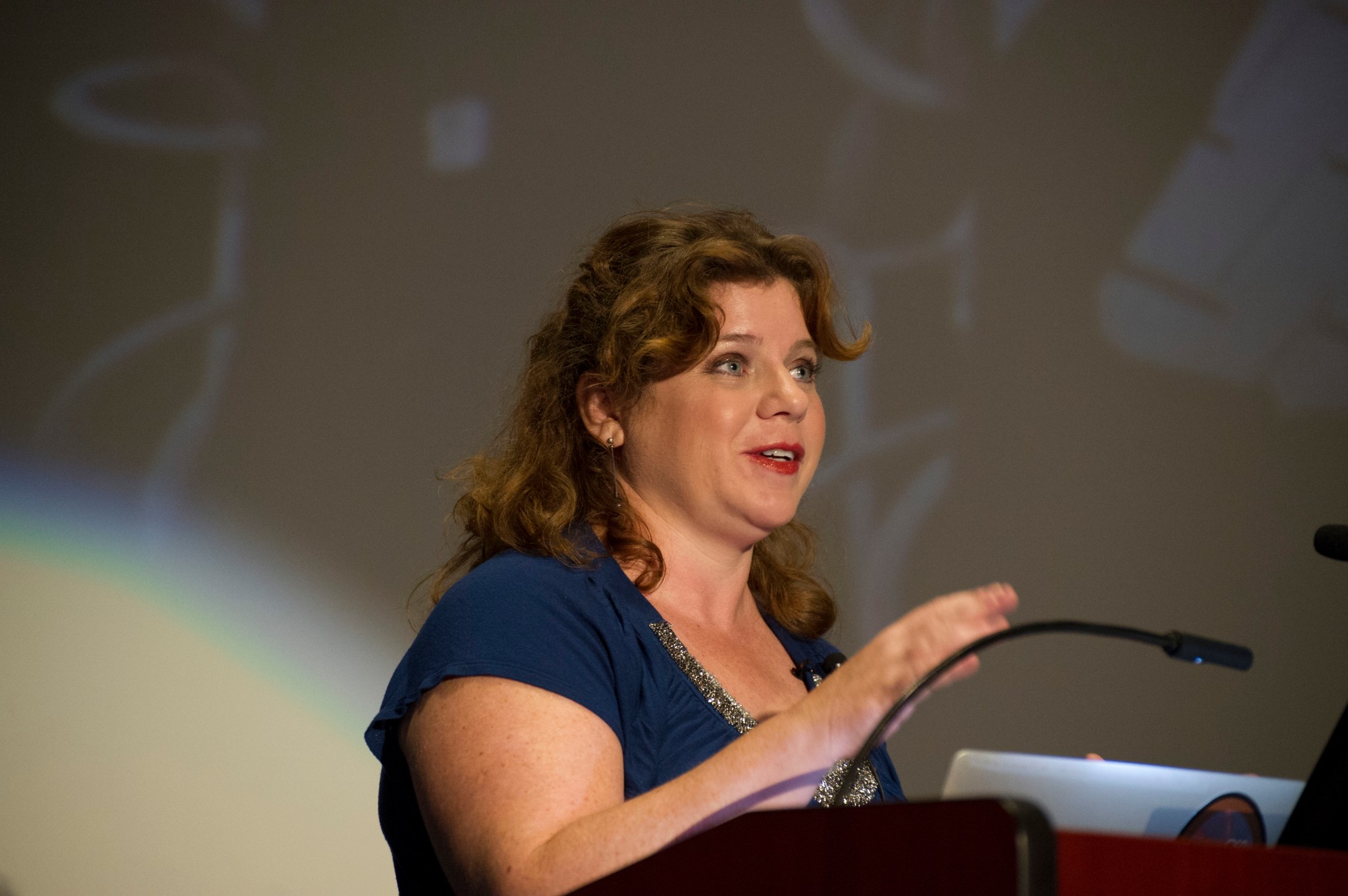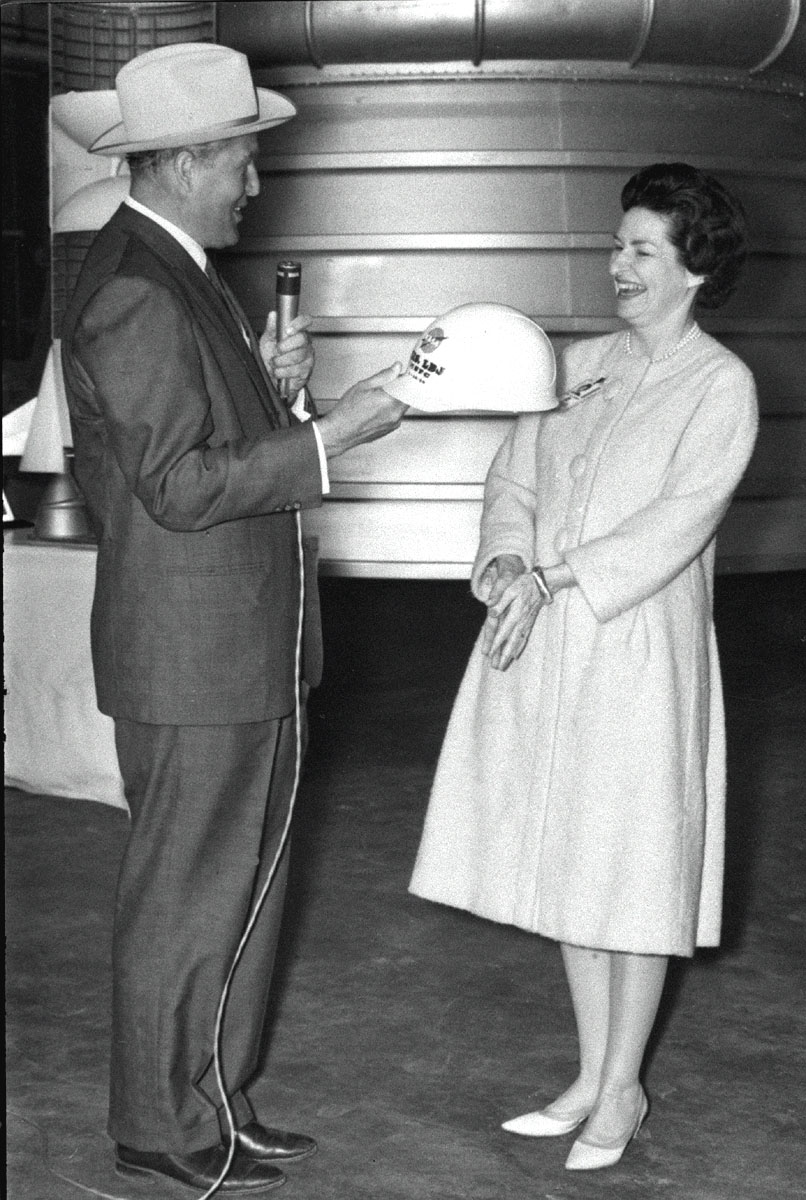In This Week’s Star
- Marshall Scientist Barbara Cohen Added to Mars Curiosity Rover’s Science Team
- New Robotic Competition Comes to Von Braun Center March 24-26
- Secretary of Education Brings Educational Tour to Huntsville
- Marshall Team Invited to Women’s History Month Event March 30
- Safety Culture Survey Underway at Marshall
- This Week in NASA History: Lady Bird Johnson Visits Marshall — March 24, 1964
- Obituaries
Marshall Scientist Barbara Cohen Added to Mars Curiosity Rover’s Science Team
Barbara Cohen, a planetary scientist at NASA’s Marshall Space Flight Center, has been selected as one of the 28 participating scientists for the Curiosity Mars rover mission.
Cohen, a geochemist, was also a member of the science operations teams for the Mars exploration rovers Spirit and Opportunity, but this will be her first chance to work with the Mars Science Laboratory Project — Curiosity. She will be part of a science team of about 120 members, mainly principal investigators and co-investigators for the rover’s 10 science instruments, plus about 320 science-team collaborators, such as the investigators’ associates and students.
An initial group of Mars Science Laboratory participating scientists was chosen before Curiosity’s 2012 landing on Mars, and several were selected again in the latest round. Participating scientists on the mission play active roles in the day-to-day science operations of Curiosity, involving heavy interaction with rover engineers at NASA’s Jet Propulsion Laboratory.
Cohen’s work focuses on the formation and evolution of Earth, its moon, Mars and asteroids — particularly the age determination of rocks on other planets. Currently, this type of dating is only possible by returning the rocks to Earth, but Cohen is developing new techniques to make this possible throughout the solar system.
Her research proposal requested the use of three tools already on the rover to help develop the Potassium-Argon Laser Experiment — a chemical-analyzing laser that could help date and identify rocks on the Red Planet. Cohen will use Curiosity’s Chemical Camera and Sample Analysis at Mars spectrometers and the Mars Hand Lens Imager camera to learn how the technique could actually work on Mars.
“With Potassium-Argon dating, you are able to determine the age of a rock,” said Cohen. “This is important because we all agree that Mars was once warm and wet, but the question we are hoping to answer is ‘when?’ When was it wet? Yesterday? A billion years ago, or at the beginning of the solar system? We don’t know that, because we don’t have any absolute ages to put on that.”
“Potassium-Argon dating could tell us when a rock was formed and when it became altered by water. This would be huge and give us the absolute ages we are looking for.”
Cohen hopes information gained from her work as a member of the Curiosity science team could help prepare the Potassium-Argon Laser Experiment for possible future Mars rover missions.
Cohen is one of six participating scientists who are new to the mission, including Christopher Fedo, University of Tennessee, Knoxville; Raina Gough, University of Colorado, Boulder; Briony Horgan, Purdue University, West Lafayette, Indiana; Christopher House, Pennsylvania State University, University Park; and Mark Salvatore, University of Michigan, Dearborn.
During Curiosity’s prime mission, which was completed in 2014, the project met its main goal by finding evidence that ancient Mars offered environmental conditions with all the requirements for supporting microbial life, if any ever existed on Mars. In Curiosity’s first extended mission, researchers are using the rover on the lower portion of a layered mountain to study how Mars’ ancient environment changed from wet conditions favorable for microbial life to harsher, drier conditions. For more information about Curiosity, click here.
New Robotic Competition Comes to Von Braun Center March 24-26
By Christopher Blair
It’s the March Madness of robotic competitions. Student-built robots will be going head-to-head in battle during this week’s “Rocket City Regional” — Alabama’s inaugural FIRST Robotics Competition — in the South Hall of the Von Braun Center March 24-26.
Nearly 1,500 students from 11 states will compete in “FIRST Stronghold,” a medieval-themed game where robots must storm castles, breach defenses, launch foam boulders and capture opposing towers. The event is free and open to the public, and will include music, dancing and hands-on educational activities provided by sponsors and exhibitors.
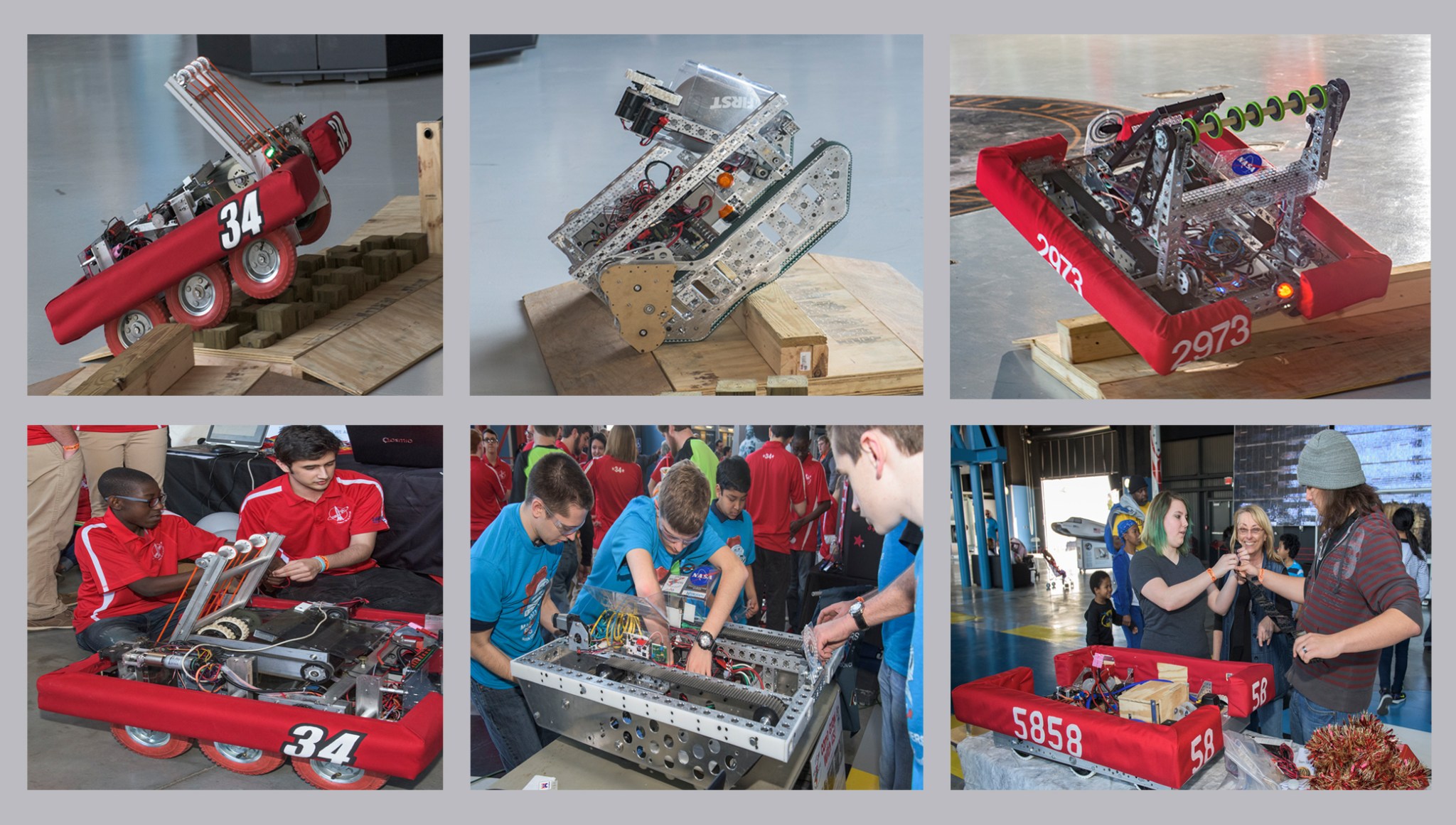
Part of FIRST Robotics Competition, a worldwide program for students in grades 9-12, the event is designed to inspire the next generation of scientists and explorers to pursue careers in the STEM fields of science, technology, engineering and math. FIRST — which stands for “For Inspiration and Recognition of Science and Technology” — helps young people solve engineering design problems in a fun and competitive way.
Local schools participating in the Rocket City Regional include The Mad Rockers, with students from Bob Jones and James Clemens high schools in Madison; Morgan County Mech Tech, comprised of students from A.P. Brewer, Priceville, Danville, Falkville and West Morgan high schools in Morgan County; and Team G.R.E.A.T. from Grissom High School in Huntsville.
The opening ceremonies will begin at 8:30 a.m. CDT, with qualification matches starting at 9 a.m. both March 25 and 26. The March 25 awards ceremony will begin at 5:45 p.m., while the March 26 awards ceremony will begin at 4:30 p.m.
The Rocket City Regional is one of several dozen district and regional competitions held across the country in March and April, providing teams a chance to qualify for the 2016 FIRST Championship at the Edward Jones Dome, April 27-30 in St. Louis. One local team — the Apex Predators of Huntsville High School — has already qualified for the world championships in its division.
Which teams will be next to punch their tickets to the championship? Join the anticipated cheering fans this week and find out. For more information, click here.
Blair, an ASRC Federal/Analytical Services employee, supports the Office of Strategic Analysis & Communications.
Secretary of Education Brings Educational Tour to Huntsville
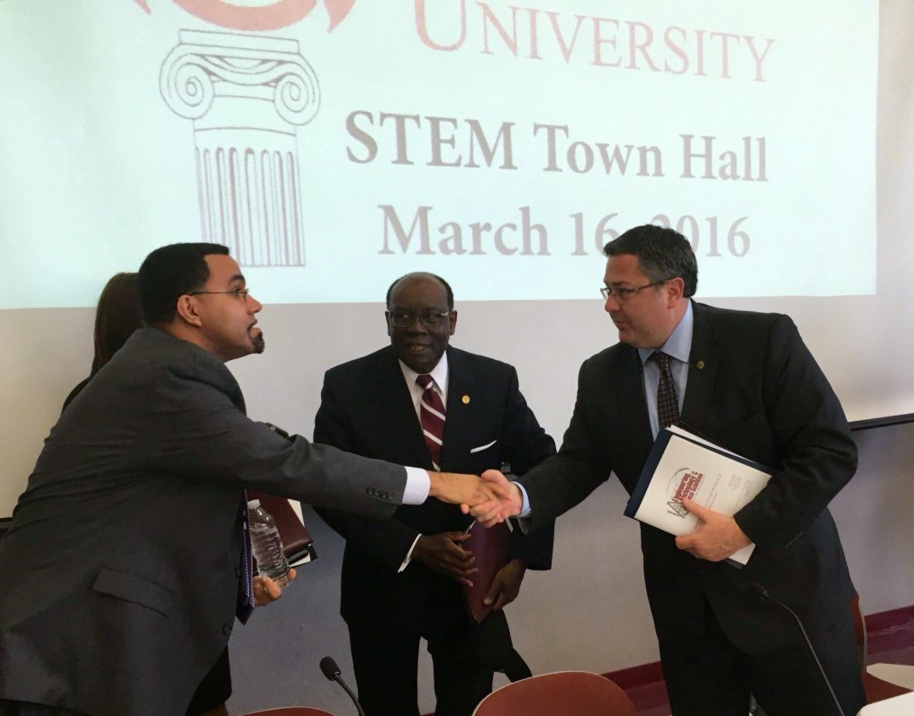
Secretary of Education Bill King, left, thanks Alabama A&M University President Andrew Hugine, center, and NASA Marshall Space Flight Center Director Todd May for participating in his “College Opportunity Across America” tour, hosted at Alabama A&M March 16. The town hall meeting discussed the impact of Historically Black Colleges and Universities toward meeting the nation’s STEM needs in science, technology, engineering and math. During his multi-state tour, the newly confirmed secretary will hear from students and campus leaders about innovative strategies increasing access, affordability and positive outcomes for students. (NASA/MSFC/Christopher Blair)
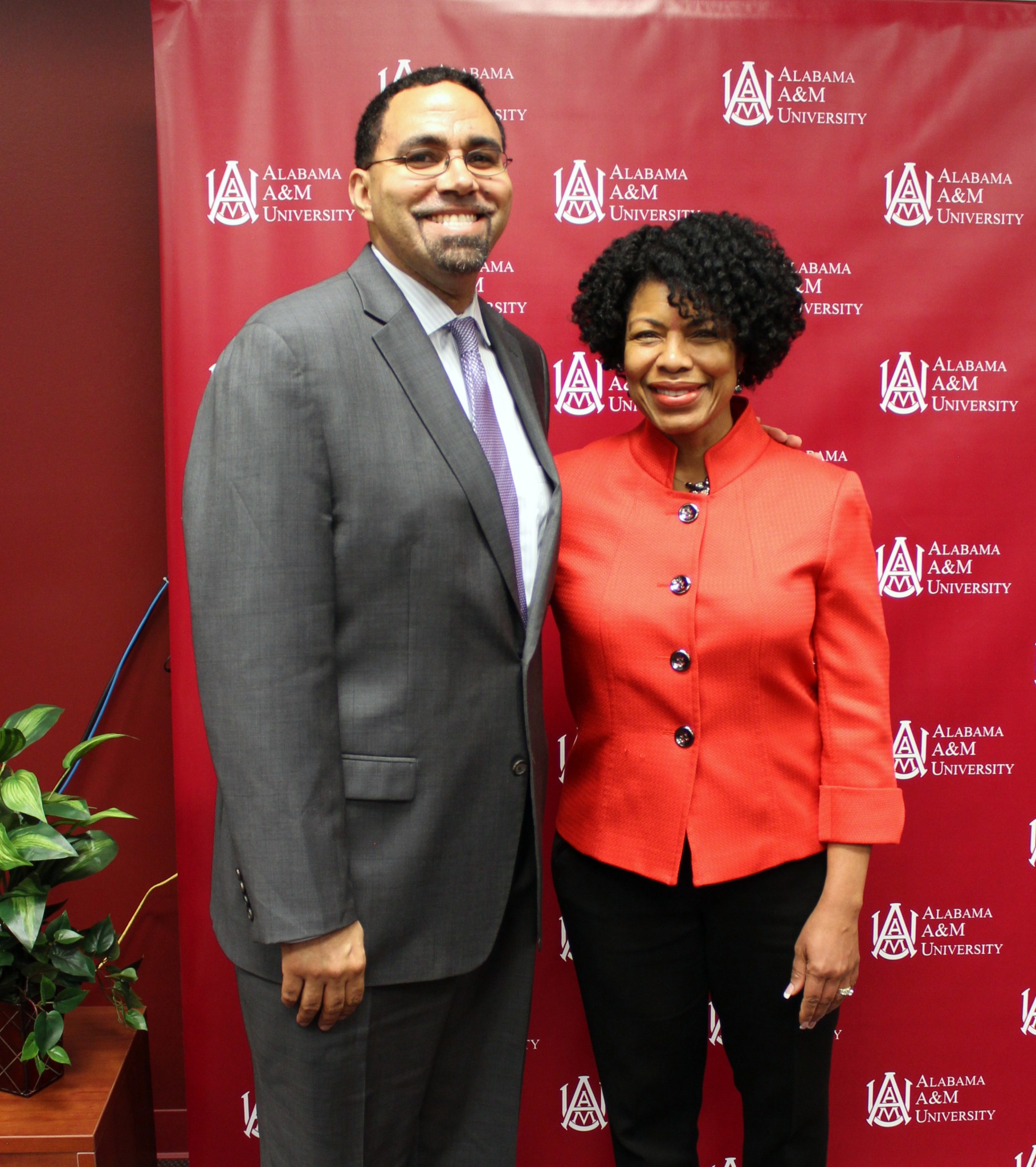
U.S. Secretary of Education John King Jr., left, greets Sheila Nash-Stevenson of Marshall’s Planetary Missions Program Office. Nash-Stevenson — the first recipient of a master’s degree in physics from Alabama A&M University and the first African American female in Alabama to earn a doctorate in physics — was a special guest for the town hall meeting, held in honor of “Women’s History Month” and women’s accomplishments in the STEM fields. (NASA/MSFC/Christopher Blair)
Marshall Team Invited to Women’s History Month Event March 30
NASA’s Marshall Space Flight Center will host a lunch-and-learn event March 30 on the subject of “Women and Heart Disease,” part of the center’s commemoration of Women’s History Month.
Dr. Jennifer Kiessling, a cardiologist at the Huntsville Cardiovascular Clinic, will speak at 12:30 p.m. in Building 4200, conference room 600. Marshall team members are encouraged to bring their lunches and take part.
The importance of discussing heart disease and stroke during Women’s History Month is self-evident, said Abbie Johnson, Federal Women’s Program manager in Marshall’s Office of Diversity & Equal Opportunity, which organized the event. Medical experts suggest heart disease and strokes cause one in three deaths among women each year — more than all cancers combined. Studies show that up to 80 percent of such cardiac events could be prevented with information and their effects minimized by prompt, proper action.
Kiessling will address that life-saving information and action, identifying ways to recognize early stroke symptoms and prevent heart disease.
Women’s History Month originated in 1981 as a week-long event. It became an annual, month-long tradition in 1987, per congressional decree. Since 1995, the president of the United States has issued annual proclamations designating March as Women’s History Month.
The Federal Women’s Program was established in 1967 when President Lyndon Johnson signed Executive Order 11375, adding gender as a prohibited form of discrimination. The program seeks to identify barriers to the hiring and advancement of women and to enhance employment opportunities for women in every area of federal service. As manager of Marshall’s Federal Women’s Program, Johnson serves as the center’s point of contact and advisor in matters involving the employment and career advancement of women.
More about Dr. Jennifer Kiessling
Kiessling, a Huntsville native, received a bachelor’s degree in electrical engineering in 2001 from the University of Alabama at Birmingham, and graduated from the university’s School of Medicine in 2005. Following graduation, she completed a surgical internship and then her internal medicine residency at the Baptist Health System in Birmingham. She completed her cardiology fellowship at the University of Alabama at Birmingham Hospital. Today, she is board-certified in internal medicine, cardiovascular disease and nuclear cardiology, with a keen interest in women’s heart health issues. She is a fellow of the American College of Cardiology.
Her ties to Huntsville — and to Marshall — remain strong. Her mother, Janet Kiessling, is a nurse practitioner at the Marshall Medical Center. Her father, Edward Kiessling, is manager of Marshall’s Environmental Engineering and Occupational Health Office.
Team members are invited to contact Abbie Johnson for more information.
Safety Culture Survey Underway at Marshall
NASA Marshall Space Flight Center Director Todd May encourages team members to take part in Marshall’s third Safety Culture Survey underway now through April 1.
The survey will be used to help measure Marshall’s safety culture. It also will help identify critical areas for improvement and track efforts to reaffirm personal responsibility, teamwork and a shared commitment to safety across the workforce.
Produced by the Office of Safety & Mission Assurance at NASA Headquarters, the survey is administered by Marshall’s Safety & Mission Assurance
Directorate. It should not take more than five minutes to complete.
The survey has 21 questions and is based on the five-part NASA Safety Culture Model:
- Reporting Culture: We report our concerns.
- Just Culture: We have a sense of fairness.
- Flexible Culture: We change to meet new demands.
- Learning Culture: We learn from our successes and mistakes.
- Engaged Culture: Everyone does his or her part.
Only the Safety Culture Survey administrators will have access to the data. Individual participants and their responses will not be identified.
The survey will be available through April 1. For more information about the survey, click here.
This Week in NASA History: Lady Bird Johnson Visits Marshall — March 24, 1964
This week in 1964, Dr. Wernher von Braun, left, the first center director of NASA’s Marshall Space Flight Center, presents Lady Bird Johnson with an inscribed hard hat during the first lady’s visit. While at Marshall, she addressed center employees, toured facilities and witnessed test firings of a Saturn I first stage and an F-1 engine. Von Braun is wearing a hat presented to him months earlier by President Lyndon Johnson during a visit to Johnson’s ranch in Texas. The NASA History Program documents and preserves NASA’s remarkable history through a variety of products — photos, press kits, press releases, mission transcripts and administrators’ speeches. For more pictures like this one and to connect to NASA’s history, visit the History Program’s Web page. (NASA)
Obituaries
Mildred W. Crowden, 87, of Somerville, Alabama, died Dec. 12. She retired from the Marshall Center in 1974 as a procurement clerk.
Bill Andrews, 86, of Fairview, Alabama, died March 6. He retired from the Marshall Center in 1981 as a quality assurance specialist. He is survived by his wife, Gail Andrews.
Roy L. Fanning, 93, of Huntsville, died March 20. He retired from the Marshall Center in 1974 as an industrial specialist.























